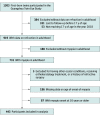Association of Age at Myopia Onset With Risk of High Myopia in Adulthood in a 12-Year Follow-up of a Chinese Cohort
- PMID: 32940622
- PMCID: PMC7499247
- DOI: 10.1001/jamaophthalmol.2020.3451
Association of Age at Myopia Onset With Risk of High Myopia in Adulthood in a 12-Year Follow-up of a Chinese Cohort
Abstract
Importance: Early-onset myopia is well known to progress to high myopia in adulthood. However, no accurate estimation of how a specific age at myopia onset is associated with the probability of developing high myopia in adulthood is available, and a very-long-term follow-up study with data from annual visits is needed.
Objective: To estimate the risk of developing high myopia in adulthood associated with a specific age at myopia onset from a data set with a 12-year annual follow-up.
Design, setting, and participants: This ongoing, population-based prospective cohort study of twins was conducted in Guangzhou, China, on July 11, 2006. Data from baseline to August 31, 2018, were analyzed. The first-born twins completed follow-up until 17 years or older, and the 443 participants (after exclusions) who developed myopia were included in the analysis. Data were analyzed from September 1, 2018, to January 20, 2020.
Main outcomes and measures: Age at myopia onset was determined by prospective annual cycloplegic refractions (365 participants [82.4%]) or with a questionnaire. Refraction in adulthood was defined as the cycloplegic refraction measured at the last follow-up visit.
Results: Among the 443 eligible participants (247 [55.8%] female; mean [SD] age at myopia onset, 11.7 [2.0] years), 54 (12.2%) developed high myopia (spherical equivalent, -6.00 diopters or worse determined by cycloplegic refractions) in adulthood. Among participants with age at myopia onset of 7 or 8 years, 14 of 26 (53.9%; 95% CI, 33.4%-73.4%) developed high myopia in adulthood; among those with onset at 9 years of age, 12 of 37 (32.4%; 95% CI, 18.0%-49.8%); among those with onset at 10 years of age, 14 of 72 (19.4%; 95% CI, 11.1%-30.5%); among those with onset at 11 years of age, 11 of 78 (14.1%; 95% CI, 7.3%-23.8%); and among those with onset at 12 years or older, 3 of 230 (1.3%; 95% CI, 0.2%-3.8%). Results of multivariate logistic regression analysis suggested that the risk of developing high myopia in adulthood decreased significantly with delay in the age at myopia onset (odds ratio, 0.44; 95% CI, 0.36-0.55; P < .001), from greater than 50% for 7 or 8 years of age to approximately 30% for 9 years of age and 20% for 10 years of age.
Conclusions and relevance: These findings suggest that the risk of high myopia is relatively high in children with myopia onset during the early school ages. Each year of delay in the age at onset substantially reduces the chance of developing high myopia in adulthood, highlighting the importance of identifying effective prevention strategies under investigation, such as increasing outdoor time.
Conflict of interest statement
Figures




References
Publication types
MeSH terms
LinkOut - more resources
Full Text Sources
Medical

